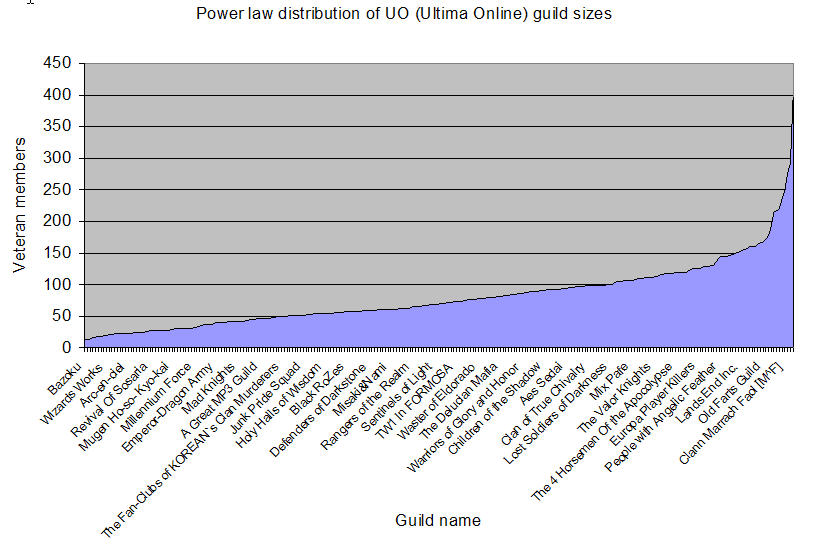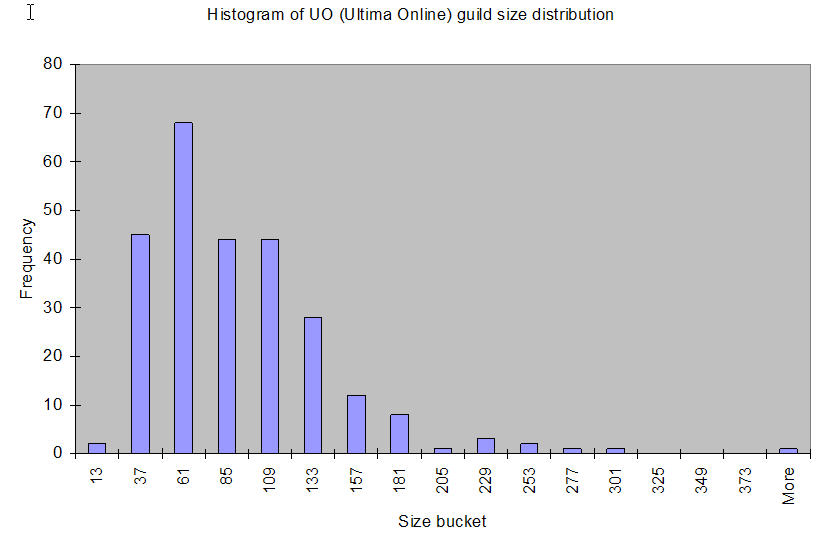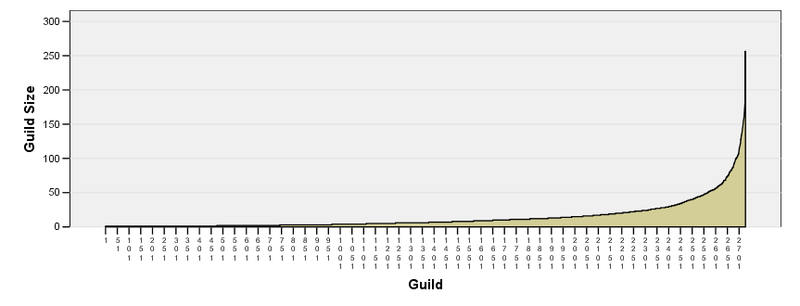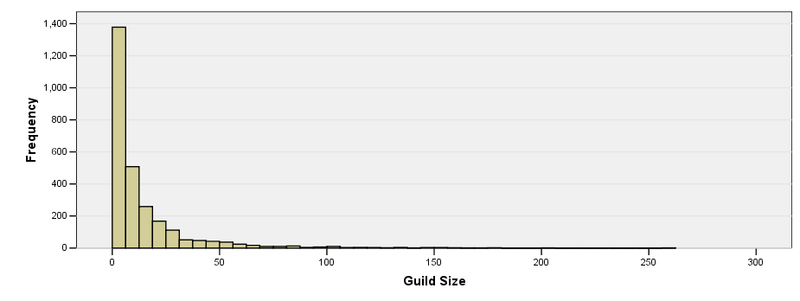In my initial blog entry on the Dunbar Number I presented some statistics on group sizes based on the online game Ultimata Online. In it you could clearly see the power-law (pareto) curve, with diminishing returns at around 150, with most groups being 60 in size:
More recently, Nick Yee and other researchers at the PlayOn Blog have been researching the behaviors of players in the popular World of Warcraft online game. At my request, they sampled guild sizes over a one-week period, and prepared similar graphs (now 404, use internet archive link):
Overall, these statistics still support my original hypothesis in my Dunbar Number post that mean group sizes will be smaller than 150 for non-survival oriented groups:
This all leads me to hypothesize that the optimal size for active group members for creative and technical groups – as opposed to exclusively survival-oriented groups, such as villages – hovers somewhere between 25-80, but is best around 45-50. Anything more than this and the group has to spend too much time “grooming” to keep group cohesion, rather then focusing on why the people want to spend the effort on that group in the first place – say to deliver a software product, learn a technology, promote a meme, or have fun playing a game. Anything less than this and you risk losing critical mass because you don’t have requisite variety.
Interestingly, the diminishing returns for large groups in World of Warcraft appear to cut off much sooner then they do in Ultima Online, with the 95th percentile 54 and the 99th percentile being 110. When I asked about why the ‘knee’ was much closer to 50 rather than Ultima Online’s knee around 150, Raph Koster (the game designer who gave me the original Ultima Online data) answered that it might be because Ultima Online used a “veteran member” method of counting. This could result in under reporting of new users and thus pushing up sizes of more established groups.
Also different was the fact that the World of Warcraft guild sizes display a reverse power-law, with the smallest groups being much more common, rather then the bell curve of Ultima Online. If one-person guilds are excluded, the average guild size was 16.8, the median was 9. This seems to correspond much closer to my thoughts on a smaller ‘nodal’ threshold for group size that I’ve observed at around 15, which I describe in Dunbar, Altruistic Punishment, and Meta-Moderation.
My guess is that there is something about Worlds of Warcraft such that even participating in very small groups can be useful, whereas for Ultima Online the utility is gained mainly by sharing the resources earned by larger groups. Thus Worlds of Warcraft has groups that are “bands” as well as “tribes”, while with Ultima Online groups are more llikely to be just “tribes”.
I’ve not had time to play Worlds of Warcraft yet, so I’m curious if those who have more experience would agree with my hypothesis.
Some other posts about the Dunbar Number and group size issues:
Comments
I play WoW on a regular basis, and I have to admit that I was a bit surprised by the preponderance of small guilds, as the best high-end gear is available in instances that require raids involving large groups of high-level players (up to 40 people). In fact, this is an oft repeated complaint on the WoW forums: smaller guilds do not have access to this gear unless they can manage to form alliances with other small guilds. However, for low and mid-level players, going through instances only requires 5-player groups, and instances are usually the best source for great gear at every level, so for those players who haven’t reached level 60 yet, there is no immediate advantage to joining a large guild. I would therefore be curious to see a correlation between player level and guild size.
Sylvie Noel 2005-08-04T06:30:11-07:00
I play WoW and I’ve never played UO but I’ve heard from many MMORPG veterans that WoW is far too kind in terms of its penalities for death. In fact, there’s little penalty for death besides 10% damage to your equipment (easily repairable) and walking your spirit back your corpse. In other games, things like gold, items, rank and experience can be lost as a result of character death. This could mean that there’s simply less of a survival mentality amoungst players and groups are formed for rewards rather than for aversion of penalties.
Jack 2005-08-04T20:42:49-07:00
I don’t know about UO, but WoW features individualised gear. Certain gear, once “owned,” simply cannot be passed on to someone else. As such, in the earlier levels, it’s possible that players not even bother to join a guild. It’s entirely viable to solo up until the high level instances. There isn’t as much dependence on grouping. My opinion, of course. YMMV.
Ian 2005-08-05T11:04:35-07:00
Some sent me an email, asking to be quoted anonymously: Some facts about WoW guild sizes: What is the point of a guild with one member? Since the guild name is displayed with your character, then it is like a last name for your character ( a further way to show how clever you are) even a guild of one can have it’s own guild tabard Guild of less then 5: You can only have 2 professions so it is worthwhile to team up with others that you can trade goods with tailoring/enchanting mining/blacksmithing skinning/leather-working there is also mining/engineering but almost none of the stuff engineers make can be shared so for lower level character a group of 3 can be VERY helpful, also 3 is an easy to maintain group size and obviously the killing/questing goes much faster. This group falls apart for characters higher then 30 (for reason listed below) Guilds of around 5+: Most instance dungeons must be done with 5 players, each with a role (tank, healer, damage, off-tank, off-healer), a 3 player guild will need 2 pick-up players. Pick-up players, as a rule, are used to playing solo and don’t stay in a role as well, leading to lots of problems. Guilds of around 40+: High lvl dungeons need 40 players, so I think your results would look extremely different if you only showed lvl 50 or higher characters also blacksmithing splits into 2 specialties and leather-working splits into 3 specialties leading to larger group size. Another thing that affects group size is “alts”, if I create a killer guild, I am going to want all my characters to belong to it, even if I don’t play them anymore. So by looking a just lvl50 or higher characters I think you would strip out a lot of “alts”, and that would give a better “real” group size
Christopher Allen 2005-08-05T13:23:17-07:00
URL: WoW has taken a lot of steps to enable players to find players to group with, such as dedicated chat channels and a system allowing players to join a queue and be automatically placed in groups. Also WoW is incredibly solo-friendly - you never need to group to get to level 60, and even some endgame content is accessible such as the PvP Battlegrounds. The points already mentioned about the simple tradeskill structure and absence of tradeable ‘hand-me-downs’ are crucial as well, so I’m not too surprised you see a smaller average guild size. If WoW incorporated a working formal alliance structure you might see it splinter even more. On a more general note, if a guild is being formed for 40-person raids, only the hardest of the hardcore will actually have 40 players - they’d want sufficient numbers to be able to routinely get 40 players of appropriate level and class distribution together. My WoW guild has reached sizes where 40-person groups are sometimes possible spontaneously. In my opinion we’re skirting, and probably have crossed into, the ‘too-large’ realm. I find I’m more likely to ignore guild chat, simply because there are so many people and things going on. I also don’t feel as close to guildmates - to the point of not recognizing some - which has never happened to me before. I blame the game. WoW owes much of it’s success to being more casual friendly, and has a tendency to attract and even promote less social playstyles. I notice my behavior is changed from past MMO’s when I was perfectly happy to just chat for awhile. In WoW everything is go, less (or no) downtime between fights, more interaction needed during battles (I most often play a rogue, which plays more like a FPS than anything else), less travel time, it all adds up to a game which is very fun, yes, but definatley less social. P.S. Anyone studied the effects of Teamspeak on optimal group/raid/guild sizes?
Staarkhand 2005-08-15T10:54:30-07:00
I play WoW and I played UO in the past but I’ve heard from many MMORPG friends and veterans that WoW is far too kind in terms of its penalities for death. So I agree with Jack
John23 2005-09-16T05:29:19-07:00
Well said. I totally agree with you. The point you are making here does make sense. And all those who oppose your views actually lack the basic essence of the subject. You must keep doing the good work. Tedd http://www.yahoo.com
john 2005-09-24T04:48:33-07:00
URL: World of Warcraft is actually quite intricate in its workings. The style of play often changes with the level of the player’s character(s). Also, the ruleset a person is playing on influences how they group and interact with people. For instance, on the PvP servers, now that the majority of players have had high level characters for a while, practically no one does low-level instances. People are either busy in battlegrounds (BG’s) or high level instances. So most people who aren’t level 60 end up soloing or grouping with very few people. But a guild is ideal to have, as you can call people in for backup when enemy players are ganking you while levelling up. But this makes the size of these guilds rather arbitrary. When a person reaches level 60 on the PvP servers, they tend to join a guild that participates in PvP fairly often. It doesn’t require many people to PvP, as some BG’s only allow 10 people. And those BG’s that allow more are difficult to get into, so people only enter in small groups anyway. Even for the small BG’s it can be difficult to enter the server with a predetermined group, due to the way the queueing system works. So the desire for small groups on PvP servers is high (as it is easier to enter the BG’s). This can make some guilds fairly small. It should be noted about the PvE ruleset that a lot of low-level players are able to participate in low-end 5-to-10-man dungeons (almost always done with 5), as the interest in fairly high amongst those levelling up alts and new players. So people new to this low-level content often join small guilds, or guilds with a vast number of low-level alts. Now, when people participate in high-level dungeons, things are a little different. Really, there is only one high-level dungeon that is for five people. And there are a few high-level dungeons that allow for 10 or 15 people, but neither they nor the 5-man dungeon offer the best loot. This causes only casual players to really concentrate on that content. Sometimes, a player will want to approach the game in a serious, hardcore manner, but because they can’t handle large groups or are generally anti-social, they may end up staying in a smaller guild. I’ve encountered three cases of this, all of which involved personal online gaming friends. In terms of hardcore, high-level content, you have three 40-man dungeons (however, I’d classify one of them as a simple encounter), one 20-man dungeon and two outdoor, 40-man encounters that offer the best loot. With the addition of the 20-man raid dungeon, I expect average guild sizes will fall slightly. But I’m sure there will be plenty of guilds concentrating on the 40-man PvE content. In order to do the complex 40-man raid dungeons, you need a guild that has at least 40 people that can play regularly, the right class setup, and backups to take the place of crucial missing pieces. However, I have often found that there are “regulars” that show up to almost every raid. This means the number of backups is usually relatively small. This explanation is not very eloquent, I realize, but I hope it brings some insight into things. It’s rather a subjective opinion, as well. I don’t have numbers to back this up–it’s all based on personal experience with both rulesets.
Steve 2005-09-27T00:11:25-07:00
URL: I saw your open question as to whether World of Warcraft had some characteristics that caused it to trend towards lower guild sizes. I’ve been playing World of Warcraft since release. In short, your answer is “yes”. Compared to other MMOs, World of Warcraft is different in significant respects. The level grind to cap (60) is -much- less intense than in comparable games. I believe that the average time to 60 in terms of days played is about 15 days and it can be much less for a veteran player. WoW is very quest-oriented and a majority of quests are accomplishable solo. Quests usually fall into the typical categories of kill-quests, loot-quests, and Fedexes. If you want to level quickly, you do this by solo grinding and cherry-picking quests. On the path to 60, WoW offers several instanced raid dungeons. On the alliance side, there’s Deadmines, Stockades, Shadowfang Keep, Uldaman, Scarlet Monastery, Zul’Farrak, Maraudon, Sunken Temple. These instances have some quests in them, but, in addition, they’re participant-capped. No more than 5 grouped players can be in the instance parts of these dungeons. This has the effect of allowing guilds with less than 5 regular people to successfully reach level cap as a social group. Once a player reaches 60, however, things start to change. 60th level players very quickly exhaust the number of quests that are available to them. This leaves only the high-end instances to do: Blackrock Depths Stratholme Scholomance Blackrock Spire Zul’Gurub Molten Core The maximum number of players who can participate on these endgame instances increases dramatically. Blackrock Depths is limited to 5 participants. Strat and Scholo are 10, I think. Blackrock Spire is 15. Molten Core is 40. Zul’Gurub is a new “starter” raid instance that requires 20. Small guilds who make it to 60 often find that they are ‘stranded’, without enough critical mass to perform the higher level raid instances but without the connections to join with other guilds to participate in them. This abrupt transition of the gameplay at the end from casual to hardcore is a common player complaint. Another factor that may lead to smaller guild sizes in the endgame compared to Ultima Online is that practically all raid content IS instanced. This means that to get the best loot, a guild needs to be able to muster only the raid-limit cap for that particular instance. In contrast, in Ultima Online, my understanding is that many of the end-game bosses are out ‘in the open’ and on long spawns. This means that to achieve success, guilds in that game not only need to be able to muster enough players to defeat the raid encounter but must ALSO achieve enough mass in order to prevent other guilds from dominating the spawn. This becomes a sheer numbers game.
Chris Pearce 2005-10-03T06:50:01-07:00
URL: While I have not played WOW, in EVE-online another MMPOG, the occurence of corporations smaller than 3 is usually because the members are subverting the rules. samll corps exist so that people can play solo, outside of the normal social infrastructure. In dangerous areas the new player corps are normally Kill On Site, so experienced solo players create a corp for the small number of characters that individual person operates. small corps exist so that you can declare war and blackmail other corps without your main corp suffering any fallback. Or they serve as peoples murderous ‘alt’ characters, again so that you can avoid any come back onto your main character or corp. small corps exist so that they can create clones without needing to build high standing of your main corp (a sort of game exploit). small corps exist to scam money out of people by creating fake lotteries etc small corps exist so that an alt character can run a business away from the normal agreed rules of the corp that the main character is part of. If similar things happen in other MMPOGs, it might be worth ignoring the small groups when drawing conclusions about social groups, they usually exist to either be explicitly anti-social or to subvert the game mechanics in some way.
Dave C 2006-05-08T04:37:50-07:00
URL: hi!can you help me with sth?? i want to make faster lvl can you help me plz:😥
oday 2006-11-09T06:13:06-07:00
Life With Alacrity
© Christopher Allen





